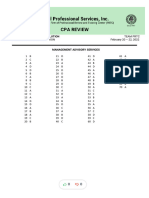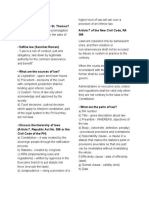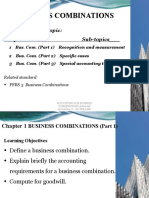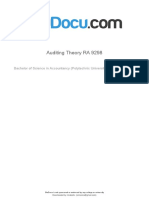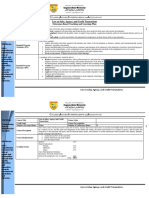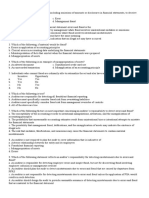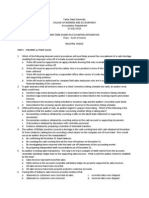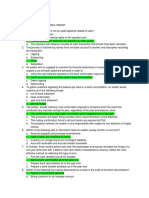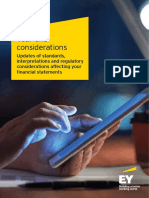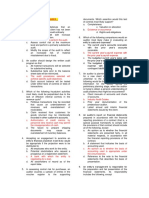1.
An auditor would consider a cashier’s job description to contain compatible duties if the cashier
receives remittance from the mailroom and also prepares the
a. Daily deposit slip. c. Remittance advices.
b. Prelist of individual checks. d. Monthly bank reconciliation.
2. Which of the following internal control procedures will most likely prevent the concealment
of a cash shortage resulting from improper write-off of a trade account receivable?
a. Write-offs must be supported by an aging schedule showing that only
receivables overdue for several months have been written off.
b. Write-offs must be approved by the cashier who is in a position to know if the
receivables have, in fact, been collected.
c. Write-offs must be approved by a responsible officer after review of credit department
recommendations and supporting evidence.
d. Write-offs must be authorized by company field sales employees who are in a
position to determine the financial standing of the customers.
3. An entity’s internal control structure requires every check request that there be an approved
voucher, supported by a prenumbered purchase order and a prenumbered receiving report.
To determine whether checks are being issued for unauthorized expenditures, an auditor
most likely would select items for testing from the population of all
a. Cancelled checks. c. Purchase orders.
b. Approved vouchers. d. Receiving reports.
4. Which of the following auditing procedures would the auditor not apply to a cutoff bank
statement?
a. Trace year end outstanding checks and deposits in transit to the cutoff bank statement.
b. Reconcile the bank account as of the end of the cutoff period.
c. Compare dates, payees and endorsements on returned checks with the cash
disbursements record.
d. Determine that the year-end deposit in transit was credited by the bank on the first working
day of the following accounting period.
5. A client maintains two bank accounts. One of the accounts, Bank A, has an overdraft of
P100,000. The other account, Bank B, has a positive balance of P50,000. To conceal the
overdraft from the auditor, the client may decide to
a. Draw a check for at least P100,000 on Bank A for deposit in Bank B. Record the receipt but
not the disbursement and list the receipt as a deposit in transit. Record the
disbursement at the beginning of the following year.
b. Draw a check for at least P100,000 on Bank B for deposit in Bank A. Record the receipt but
not the disbursement and list the receipt as a deposit in transit. Record the disbursement at
the beginning of the following year.
c. Draw a check for P100,000 on Bank B for deposit in Bank A. Record the disbursement but
not the receipt. List the disbursement as an outstanding check, but do not list the receipt as a
deposit in transit. Record the receipt at the beginning of the following period.
d. Draw a check for at least P100,000 on Bank A for deposit in Bank B. Record the
disbursement but not the receipt and list the disbursement as an outstanding check. Record
the receipt at the beginning of the following year.
6. While performing an audit of cash, an auditor begins to suspect check kiting. Which of the
following is the best evidence that the auditor could obtain concerning whether kiting is taking
place?
a. Documentary evidence obtained by vouching credits on the latest bank
statement to supporting documents.
b. Documentary evidence obtained by vouching entries in the cash account to
supporting documents.
c. Oral evidence obtained by discussion with controller personnel.
d. Evidence obtained by preparing a schedule of interbank transfers.
7. Two months before year-end, the bookkeeper erroneously recorded the receipt of a long- term
bank loan by a debit to cash and a credit to sales. Which of the following is the most effective
procedure for detecting this type of error?
a. Analyze bank confirmation information.
� b. Analyze the notes payable journal.
c. Prepare year-end bank reconciliation.
d. Prepare a year-end bank transfer schedule.
8. Postdated checks received by mail in settlement of customer’s accounts should be
a. Returned to customer.
b. Stamped with restrictive endorsement.
c. Deposited immediately by the cashier.
d. Deposited the day after together with cash receipts.
9. The cashier of Milady Jewelries covered a shortage in the cash working fund with cash
obtained at December 31 from a bank by cashing but not recording a check drawn on the
company out of town bank. How would you as an auditor discover the manipulation?
a. By confirming all December 31 bank balances.
b. By counting the cash working fund at the close of business on December 31.
c. By investigating items returned with the bank cut-off statements of the succeeding month.
d. By preparing independent bank reconciliations as of December 31
10. An essential phase of the audit of the cash balance at the end of the year is the auditor's
review of cutoff bank statement. This specific procedure is not useful in determining if
a. Kiting has occurred.
b. Lapping has occurred.
c. The cash receipts journal was held open.
d. Disbursements per the bank statement can be reconciled with total checks written.
11. Sending accounts receivable confirmation letters to the client's customers is consistent with
the auditor's objective of validating client's receivable assertion on
a. Completeness and valuation
b. Completeness and rights
c. Existence and valuation
d. Existence and rights
12. Which of the following situations would warrant the use of a positive confirmation letter
rather than a negative confirmation letter in gathering evidence regarding a client's accounts
receivable balance?
a. Internal control risk over receivables is below the maximum, thus the auditor expects little to
no misstatement in accounts receivable.
b. Accounts receivable comprise of few customer accounts with relatively large balances.
c. There were no significant exceptions noted in the prior year audit of the same client's
account receivable balance.
d. All of the situations above warrant the use of a positive confirmation letter.
13. What action should the auditors take a reply to a positive confirmation request letter for a
material amount is not received from the customer within two or three weeks of being sent
out?
a. Qualify the audit opinion due to lack of sufficient appropriate audit evidence
b. Inform the entity's internal audit department,
c. Send out a second request to the customer.
d. Qualify the audit opinion due to material misstatement in the financial statement.
14. Which of the following procedures would an auditor most likely perform for year-end
accounts confirmations when the auditor did not receive replies to second request?
a. Review the cash receipt journal for the month prior to year-end.
b. Intensify the scudy of internal control concerning the revenue cycle.
c. Increase the assessed level of detection risk for the existence assertion.
d. Inspect the shipping records documenting the merchandise sold to customers.
15. Which of the following is correct statement regarding the use of a negative confirmation
request?
a. Unreturned negative confirmation requests rarely provide significant explicit evidence.
b. Negative confirmation requests are effective when detection risk is low.
c. Unreturned negative confirmation request indicate that alternative procedures are
necessary.
d. Negative confirmation request are effective when understatement in account balances are
suspected.
� 16. Under which of the following circumstances would the use of the blank from of
confirmations of accounts receivable most likely be preferable to positive confirmation?
a. Subsequent cash receipts are unusually difficult to verify.
b. The recipients are likely to sign the confirmations without devoting proper attention to them.
c. Analytical procedures indicate that few exceptions are expected.
d. The combined assessed level of inherent risk and control risk is low.
17. Which of the following populations should the auditor start form when testing for the
completeness of reported sales of a manufacturing company and to ascertain that all valid
sales are appropriately billed to customers and are ultimately recorded as sales?
a. Sales receipts
b. Sales Invoices
c. Sales orders
d. Goods dispatch notes
18. Sales records or invoices should be traced back to and compared with shipping documents to:
a. Ascertain that all recorded sales pertain to goods that are actually delivered to customers.
b. Esture that shipments to customers are billed.
c. Determine whether payments are properly applied to customer accounts.
d. Determine whether unit prices billed are in accordance with sales contracts.
19. The auditor wants to obtain evidence in support to the financial statement assertion of
occurrence of sales do which of the following substantive test procedure?
a. Trace the shipping documents and sales invoices to the entry in the sales journal.
b. Trace the approved customer orders to the shipping documents and the sales invoices.
c. Trace the sales invoice to the daily sales summary:
d. Trace back journal entries to the sales journal to the sales invoice and shipping documents.
20. As part of auditing the company's revenue/receipt cycle, the auditor decided to render a
sales cut off by tracing entries several days before and after the balance sheet date from the
company's sales journal to the source documents which include the sales order, the sales
invoice and the delivery receipt. Which of the following is correct regarding the sales cut-
off procedures?
a. Vouching entries several days before the balance sheet date to the source documents is
necessary to gather evidence regarding completeness assertion of receivables while vouching
entries several days after the balance sheet date to the source documents is necessary to
gather evidence regarding the existence assertion of receivables.
b. Vouching entries several days before and after the balance sheet date to the source
documents is necessary to gather evidence regarding valuation assertion of receivables.
c. Vouching entries several days before the balance sheet date to the source documents is
necessary to gather evidence regarding existence assertion of receivables while vouching
entries several days after the balance sheet date to the source documents is necessary to
gather evidence regarding the completeness assertion of receivables.
d. Vouching entries several days before the balance sheet date to the source documents is
necessary to gather evidence regarding rights assertion of receivables while vouching entries
several days after the balance sheet date to the source documents is necessary to gather
evidence regarding the valuation assertion of receivables.
You are engaged in the regular annual examination of the accounts and records of Binalonan
Manufacturing Co. for the year ended December 31, 2020. To reduce the workload at year end, the
company, upon your recommendation, took its annual physical inventory on November 30, 2020.
You observed the taking of the inventory and made tests of the inventory count and the inventory
records.
The company’s inventory account, which includes raw materials and work-in-process is on
perpetual basis. Inventories are valued at cost, first-in, first-out method. There is no finished goods
inventory.
The company’s physical inventory revealed that the book inventory of P1,695,960 was understated
by P84,000. To avoid delay in completing its monthly financial statements, the company decided
not to adjust the book inventory until year-end except for obsolete inventory items.
Your examination disclosed the following information regarding the November 30 inventory:
a. Pricing tests showed that the physical inventory was overstated by P61,600.
�b. An understatement of the physical inventory by P4,200 due to errors in footings and
extensions.
c. Direct labor included in the inventory amounted to P280,000. Overhead was included at the
rate of P200% of direct labor. You have ascertained that the amount of direct labor was
correct and that the overhead rate was proper.
d. The physical inventory included obsolete materials with a total cost of P7,000. During
December, the obsolete materials were written off by a charge to cost of sales.
� Your audit also disclosed the following information about the December 31 inventory:
a. Total debits to the following accounts during December were: Cost
of sales P1,920,800
Direct labor 338,800
Purchases 691,600
b. The cost of sales of P1,920,800 included direct labor of P386,400.
QUESTIONS:
Based on the above and the result of your audit, determine the following:
21. Adjusted amount of physical inventory at November 30, 2020
a. P1,715,560 b. P1,845,760 c. P1,631,560 d. P1,722,560
22. Adjusted amount of inventory at December 31, 2020
a. P1,509,760 b. P1,502,760 c. P1,516,760 d. P1,425,760
23. Cost of materials on hand, and materials included in work in process as of December 31, 2020
a. P819,560 b. P728,560 c. P812,560 d. P942,760
24. The amount of direct labor included in work in process as of December 31, 2020
a. P618,800 b. P338,800 c. P232,400 d. P386,400
25. The amount of factory overhead included in work in process as of December 31, 2020
a. P772,800 b. P464,800 c. P1,237,600 d. P777,600
Wabwab Company engaged you to examine its books and records for the fiscal year ended
June 30, 2020. The company’s accountant has furnished you not only the copy of trial balance as of
June 30, 2020 but also the copy of company’s balance sheet and income statement as at said date.
The following data appears in the cost of goods sold section of the income statement:
Inventory, July 1, 2019 P 125,000
Purchases 900,000
Goods available for sale 1,025,000
Inventory, June 30, 2020 175,000
Cost of goods sold P850,000
The beginning and ending inventories of the year were ascertained thru physical count except that
no reconciling items were considered. Even though the books have been closed, your working paper
trial balance show all account with activity during the year. All purchases are FOB shipping point.
The company is on a periodic inventory basis.
In your examination of inventory cut-offs at the beginning and end of the year, you took note of the
following:
July 1, 2019
a. June invoices totaling to P32,500 were entered in the voucher register in June. The
corresponding goods not received until July.
b. Invoices totaling P13,500 were entered in the voucher register in July but the goods received
during June.
�June 30, 2020
c. Invoices with an aggregate value of P46,500 were entered in the voucher register in July, and
the goods were received in July. The invoices, however, were date June.
d. June invoices totaling P18,500 were entered in the voucher register in June but the goods
were not received until July.
e. Invoices totaling P27,000 ( the corresponding goods for which were received in June) were
entered the voucher register, July.
f. Sales on account in the total amount of P44,000 were made on June 30 and the goods
delivered at that time. However, book entries relating to the sales were made in July.
QUESTIONS:
Based on the above and the result of your cut-off tests, answer the following:
26. How much is the adjusted Inventory as of July 1, 2019?
a. P125,000 b. P157,500 c. P144,000 d. P92,500
27. How much is the adjusted Purchases for the fiscal year ended June 30, 2020?
a. P973,500 b. P960,000 c. P900,000 d.P978,500
28. How much is the adjusted Inventory as of June 30, 2020?
a. P196,000 b. P223,000 c. P240,000 d. P125,000
29. How much is the adjusted Cost of goods sold for the fiscal year ended June 30, 2020?
a. P877,500 b. P829,000 c. P992,500 d. P891,000
30. The necessary compound adjusting journal entry as of June 30, 2020 would include:
a. A debit to Inventory, 6/30/20 of P21,000.
b. A debit to Purchases of P73,500.
c. A credit to Retained Earnings of P32,500.
d. A credit to Vouchers Payable of P73,500.
31. The auditor of Number Block Company on adoption of PAS 41 has reclassified certain assets
as biological assets. The total value of the forest assets is P6,000,000 which comprises:
Freestanding trees 5,100,000
Land under trees 600,000
Roads in forests _ 300,000
6,000,000
In Number Block Company's statement of financial portion, how much of the forest assets shall be
classified as biological assets?
a. P5,100,000 c. P5,400,000
b. P5,700,000 d. P6,000,000
32. WAPWAP Company is a producer of coffee. The auditor is considering the valuation of its
harvested coffee beans. Industry practice is to value the coffee beans at market value and uses as
reference a local publication "Accounting for Successful Farms".
On December 31, 2020, the entity has harvested coffee beans costing P3,000,000 and with fair
value less cost to sell of P3,500,000 at the point harvest.
� Because of long aging and maturation process after harvest, the harvested coffee beans were still
on hand on December 31,2020. On such date, the fair value less cost to sell is P3,900,000 and the
net realizable value is P3,200,000.
The coffee beans inventory shall be measured at
a. 3,000,000 c. 3,200,000
b. 3,500,000 d. 3,900,000
Use the following information for the next two questions.
Rizal Lite Company provided the following data to its auditor:
Value of biological asset at acquisition cost on December 31,2019 P
600,000
Fair valuation surplus on initial recognition at fair value on December 31, 700,000
2019
Change in fair value to December 31, 2020 due to growth and price 100,000
fluctuation
Decrease in fair value due to harvest 90,000
33. What is the carrying amount of the biological asset on December 31, 2020?
a. 1,400,000 c. 1300,000
b. 1,310,000 d. 1,490,000
34. What is the gain from change in fair value of biological asset that should be shown in the 2020
income statement?
a. 100,000 c. 710,000
b. 800,000 d. 10,000
35. Majo Company provided the following data:
Value of biological asset at acquisition cost on
December 31, 2019 600,000
Fair valuation surplus on initial recognition at
Fair value on December 31, 2019 700,000
Change in fair value to December 31, 2020 due
To growth and price fluctuation 100,000
Decrease in fair value due to harvest 90,000
What is the gain from changing in fair value of biological asset that should be reported in the 2020
income statement?
a. 100,000
b. 800,000
c. 710,000
d. 10,000













